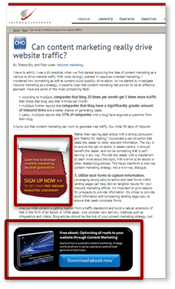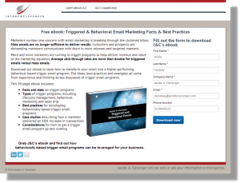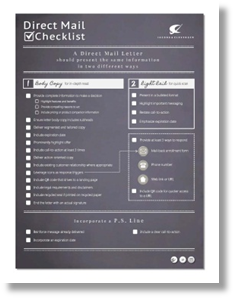

J&C Blog
Find all the latest marketing trends on the J&C Blog.

Find all the latest marketing trends on the J&C Blog.

Content marketing is one of the hottest topics in marketing right now. Many marketers are formulating their content marketing strategies and executional plans. As marketers begin to leverage content marketing as a new vehicle for reaching customers and prospects, they’ll be faced with challenges.
Content marketing requires time and commitment to do it right. There are many different components of an effective content marketing strategy. Blog articles, ebooks, videos, checklists, SEM, search marketing, social media and landing pages are all key components to the optimal content marketing tactical plan.
We’ve compiled a list of tips that can help you elevate your content marketing strategy efforts. Here are 13 considerations to ensure your content marketing efforts are firing on all cylinders.
 1. Leverage up-front analytics to inform and shape content marketing topics.
1. Leverage up-front analytics to inform and shape content marketing topics.
Analytics help ground any strategy and definitely build depth into a content marketing strategy. A keyword analytics tool helps gauge which keywords should be prioritized for content development. Factors include difficulty to rank against keywords and accessibility of content development for those keywords. Grounding the content strategy in analytics ensures a strategically sound approach.
2. Review analytics to determine which articles should be leveraged for further content development, such as ebooks.
Give the people what they want. The first step is to review articles to determine which ones are generating the most interest. I’m always a fan of considering multiple metrics, including total views, social media clicks, comments and any other engagement measurements. Make additional content development vehicles such as ebooks and checklists available for download through blog article readership and engagement. This ensures downloadable content is built off actual behavior and interests.
3. Measure and continually improve.
Content marketing provides immediate feedback to users’ interests. Analyzing behavior across a number of different dimensions can help shape all content marketing efforts going forward.
4. End each blog article with a call-to-action.
Incorporate a call-to-action that leads the reader to other relevant content. This is a critical technique in migrating content marketing to a more response-oriented technique. The key is to ensure the call-to-action is reader-centric. It should benefit the reader, and not be something that is self-serving in any way. Provide the reader with a mechanism to learn more about the topic, with a drive to an ebook or other related blog articles. This helps transform a one-way content marketing strategy into a two-way dialogue.

5. Incorporate banner ads at the end and throughout articles.
Banner ads are an effective device to incorporate within blog articles. The banner device serves as strong call-to-action and helps direct the reader to other useful content within your website. For example, if the article is on best practices, consider developing an ebook or checklist on the topic that drives users to a landing page to download this content. A banner ad can also serve as imagery throughout the article to break up the copy and content.
Banner ads should be tailored by specific article content. It’s essential to ensure banner ad content is consistent and complementary to the article, delivering relevancy.
6. Incorporate banners throughout your website.
Incorporating banner ads throughout your website on pages that relate to blog articles is also an effective way to optimize your content marketing efforts. This tip is similar to incorporating banner ads in articles. Extending the promotion of content downloads throughout your website fully leverages both website traffic and content marketing efforts.
7. Link relevant product pages to blog articles, and vice versa.
Website integration between blog articles and product, service, capability or other pages is essential to ensuring your content marketing efforts are working as hard as possible. It’s essential to have links on all core web pages that refer users to relevant blog articles and other related content. This integration ensures readers can find relevant information and helps maximize opportunities to convert website visitors to leads.
8. Optimize every aspect of landing pages.
Landing pages are one of the core foundational elements for any inbound marketing strategy. Landing pages are where web visitors convert to leads. In order to ensure your content marketing strategy is firing on all cylinders, ensure your landing pages are optimized for every best practice.
 Placement of the form, incorporating calls-to-action and copy tone are all variables that can impact landing page conversions. Leveraging strong calls-to-action and lead forms within landing pages can help deliver tangible results for your inbound marketing efforts. It’s important to give reasons for prospects to provide information. Check out our ebook on optimizing landing pages to learn more about how to take your landing pages to the next level.
Placement of the form, incorporating calls-to-action and copy tone are all variables that can impact landing page conversions. Leveraging strong calls-to-action and lead forms within landing pages can help deliver tangible results for your inbound marketing efforts. It’s important to give reasons for prospects to provide information. Check out our ebook on optimizing landing pages to learn more about how to take your landing pages to the next level.
9. Strong integration of downloads in multiple formats.
People don’t all consume information in the same manner. In order to capitalize on different preferences, consider presenting information in a number of different formats. Consider the use of checklists, infographics, short-form reports (5-10 pages), ebooks, flipbooks and other mechanisms that dish up content for consumption in differing manners.
10. Consider delivery methods such as videos.
Blog articles should be the hub of your content marketing strategy. Ebooks and other downloadable documents tend to be the next natural extension, but they don’t have to be the only tactic used to deliver all content. According to The MarketingProfs B2B Content Marketing Study, videos are now viewed as the fifth most effective content type to reach B2B audiences. Get ahead of this trend and find appropriate uses for delivering content via video.
 11. Leverage checklists as a download, playing on user’s appreciation of lists.
11. Leverage checklists as a download, playing on user’s appreciation of lists.
Consider the use of checklists. Lists continue to prevail as one of the most effective types of blog articles. Leveraging checklists as a form of downloadable content can extend this popular format into something that warrants leads to provide their contact information. Always in keep in mind, anything that requires completion of a lead form needs to be comprehensive and have real value.
12. Applying behavior to deliver relevant and personalized communications.
Once users engage, leverage behavior to develop targeted, relevant communications. Applying behavioral information to personalize outbound and follow-up communications takes the entire customer experience to a more actionable level.
Leverage interactions to inform ongoing communications streams, including segmenting customers for follow-up. Personalize communications and target an individual with a series of related content.
13. Integrate content marketing with email for an integrated strategy.
Email is one of the most effective channels to marry inbound with outbound marketing. And by nature, email is an action-oriented channel. Leverage email to reach out to prospects in an educational and expert manner, following up on whatever content generated initial interest.
Incorporating or highlighting content within email to deliver ongoing educational messaging demonstrates expertise and overcomes barriers. This also ensures your content marketing efforts are working as hard as possible for your organization.
Ensure your content marketing efforts are firing on all cylinders. This article provided a series of tips to consider in ensuring your content marketing efforts are working as effectively as possible.
Topics: Inbound Marketing
303 E Wacker Drive, Suite 2030
Chicago, IL 60601
Phone: 312-894-3000
Fax: 312-894-3005